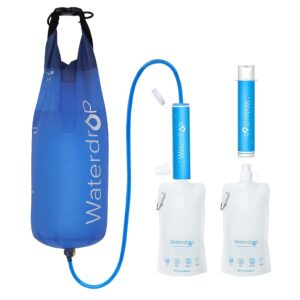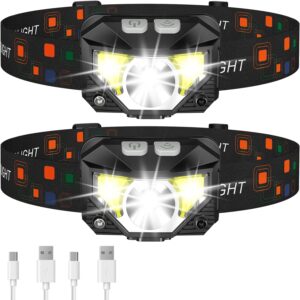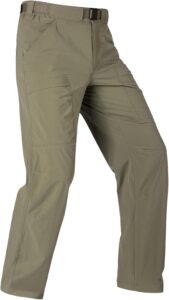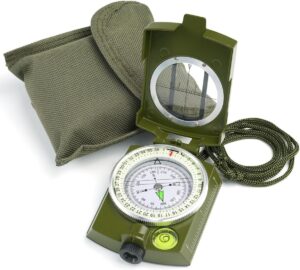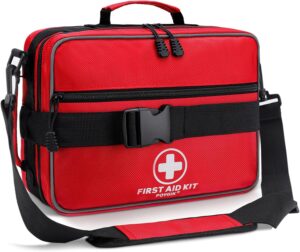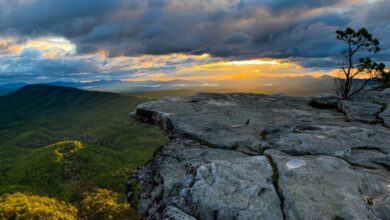The Ultimate Backpacking Checklist for Hiking and Camping
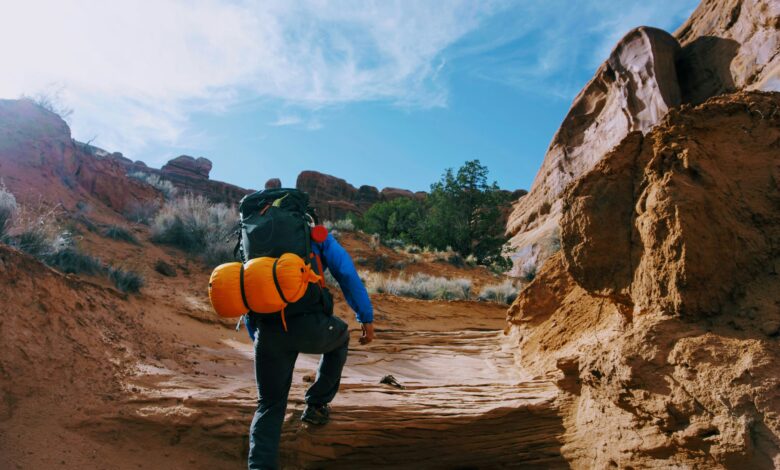
Heading into the wilderness with everything you need packed on your back is the essence of backpacking—a rewarding adventure that connects you with nature in a profound way. Whether you’re planning your first overnight trip or you’re a seasoned trail veteran preparing for a week-long journey, having the right backpacking gear can make or break your experience.
This backpacking checklist covers all the essentials you’ll need for a successful trip, from your shelter and sleep system to cooking gear and emergency supplies. We’ve organized everything by category so you have a better idea what to take hiking.
Backpack
Your backpack is literally what carries the entire adventure, so choosing the right one matters. For weekend trips, I recommend packs between 40-50 liters. If you’re heading out for longer adventures (3-5 days), you’ll want something in the 50-70 liter range
When choosing your backpack, keep these things in mind:
- A well-padded, adjustable hipbelt to transfer weight to your hips
- Shoulder straps that fit your frame without digging or chafing
- Internal frame for proper weight distribution
- Raincover or waterproof pack liner
- Compression straps to secure your load
- Various pockets and attachment points for accessibility
While ultralight backpackers might opt for minimalist frameless packs, I’ve found most hikers will be more comfortable with internal-frame packs that offer proper padding and support. Your pack should fit your torso length correctly—not too short or too long—so try it on before purchasing if possible.
Don’t forget to pack a trash compactor bag or waterproof stuff sacks to protect your gear from rain. Even with a rain cover, I’ve had water find its way in, and keeping your sleep system and spare clothes dry is important.
Shelter
Traditional tents are the most popular option because they offer protection from insects, rain, and wind in one convenient package.
For most backpackers, I’ve found a lightweight 2-person tent for camping is the perfect balance between livable space and packability. Make sure your shelter includes:
- Tent body
- Rainfly
- Poles
- Stakes
- Guylines for stability in wind
If you’re an experienced backpacker, you might consider alternatives like hammocks with rain tarps for forested areas or ultralight tarps for saving weight. These options require more skill to set them up properly but can greatly reduce the weight of your pack.
Whatever shelter you choose, practice setting it up at home before your trip so you don’t have to figure it out for the first time in the rain or dark.
A groundsheet or footprint can extend the life of your tent floor when camping on rough terrain. Even though it’s optional, I’ve found that this small investment on my camping pack list protects a much more expensive piece of gear and adds little weight to your backpacking packing list.
Water Storage and Filtration
Water is heavy, weighing about 2.2 pounds per liter, so you’ll need to balance carrying enough with being able to refill along your route. I always research water sources before my trip and pack accordingly.
For most three-season trips, you’ll want:
- Water bottles or a hydration reservoir (capacity to carry 2-3 liters)
- Water filtration system (squeeze filter, pump, gravity system, or UV purifier)
- Backup treatment method (purification tablets)
In dry regions or during hot weather, I bring collapsible containers to increase capacity when needed. Map out water sources along your route and plan to fill up when you can—this strategy saves you from carrying excessive amounts the entire time.
Remember that streams shown on maps might be seasonal or dry during certain times of the year. I always bring enough water to get me to my next confirmed source, plus extra for emergencies.
All water from the backcountry should be treated, no matter how pristine it looks. Waterborne pathogens can cause serious illness and ruin your trip.
Sleep System
Next on my backpacking checklist is a comfortable sleep system. Your sleep setup typically includes three main things:
- Sleeping bag or quilt appropriate for expected temperatures
- Sleeping pad for insulation and comfort
- Optional: pillow (inflatable or stuff a sack filled with soft items)
For three-season backpacking, I recommend a sleeping bag rated between 15°F and 30°F to make sure you stay warm enough. Down bags provide the best warmth-to-weight ratio but require careful protection from moisture, while synthetic bags work better in damp conditions.
Your sleeping pad serves two main functions, cushioning and insulation from the cold ground. I look for pads with an R-value between 2 and 5 for three-season use.
Electronics, Tools, and Accessories
Modern backpacking often includes some electronics, but I’m choosy about what I bring:
- Headlamp with extra batteries (essential for nighttime activities)
- Smartphone for photos, maps, emergencies
- Small pocket knife or multi-tool
- Power bank for longer trips
- Optional: satellite messenger or personal locator beacon for remote areas
- Optional: camera gear if photography is important to you
I keep electronics in waterproof bags and power them off when I’m not using them to conserve the battery. In cold weather, I sleep with my devices and batteries to prevent them from draining quickly—a trick I learned after waking up to a dead phone in below-freezing temperatures.
A good headlamp should be bright enough (200+ lumens) to illuminate the trail if you’re hiking after dark and have a red light mode to preserve night vision around camp.
Footwear
Your feet carry you every step of the way, so proper footwear is a must. I choose based on terrain, weather, and personal preference:
- Hiking boots: Offer ankle support and protection on rough trails
- Trail runners: Lighter weight, faster drying, more comfortable for many hikers
- Camp shoes: Lightweight sandals or foam shoes to give your feet a break at camp
No matter which style you choose, make sure your footwear is broken in before your trip, because new shoes almost guarantee blisters.
I always pack at least two pairs of appropriate socks. Merino wool or synthetic materials wick moisture and reduce blister risk.
Apparel
Dressing for backpacking means thinking in terms of layers rather than individual pieces. The right clothing system allows you to adjust to changing weather and activity levels, and it can prevent things like tick bites and skin irritation.
For a typical three-season trip, I pack:
- Moisture-wicking base layers (top and bottom)
- Quick-dry hiking pants and/or shorts
- Insulating midlayer (fleece or light puffy jacket)
- Waterproof/breathable rain jacket and pants
- Warm hat and gloves (even in summer at higher elevations)
- Sun hat
- 2-3 pairs of underwear
- 2-3 pairs of suitable socks
The old adage “cotton kills” exists for a reason—it absorbs moisture and loses insulating properties when wet. I stick with wool, nylon, polyester and other synthetic materials that dry quickly and insulate even when damp.
I pack for the worst weather I might reasonably encounter, not just the forecast. Mountain conditions can change rapidly, and being caught unprepared can be dangerous.
Stove and Cookware
Your backcountry kitchen doesn’t need to be complicated, but it should be efficient and reliable:
- Backpacking stove
- Appropriate fuel
- Pot with lid
- Utensil for eating and cooking
- Lighter or matches in waterproof container
- Cleaning supplies
- Optional: mug for hot drinks
Canister stoves are convenient and easy to use, which makes them ideal for most backpackers. For winter camping or international travel, liquid fuel stoves might be better options.
I’ve debated bringing a small hatchet on trips for processing firewood to cook my food, but decided they’re too heavy for the limited use they get. You’re better off keeping a minimal cook set.
One pot is enough to boil water for dehydrated meals or cook simple one-pot dishes, and titanium and aluminum are the most lightweight. I’ve cooked for two people with nothing more than a single 750ml pot for years without issue.
I’ve personally tried the Mountain House freeze-dried meals and I think they’re pretty good.
Food and Snacks
Balancing nutrition, weight, and convenience is important when planning your backpacking meals:
- Breakfast: instant oatmeal, granola, or breakfast bars
- Lunch: tortillas with hard cheese and salami, tuna packets, or trail mix
- Dinner: dehydrated meals, pasta, or rice with add-ins
- Snacks: energy bars, nuts, dried fruit, chocolate
- Hot drinks: coffee, tea, or hot chocolate packets
I pack an extra day’s worth of food for emergencies—something shelf-stable that requires minimal preparation. You’ll probably never need it, but you’ll be grateful to have it if you do.
If you’re in bear country, you might need a bear canister, a bear-resistant food sack, and to hang your food from a tree using the “PCT method” with a stuff sack and cord.
Most backpackers need between 2,500-4,000 calories per day, depending on body size, terrain, and mileage. Don’t skimp on calories—hunger can make a beautiful trip miserable quickly.
Personal Hygiene Products
Staying clean improves comfort and helps prevent chafing, infections, and other issues. Include these on your backpacking packing list:
- Biodegradable soap (used 200 feet from water sources)
- Hand sanitizer
- Toothbrush and travel toothpaste
- Toilet paper in ziplock bag
- Trowel for digging cat holes
- Menstrual products if needed
- Sunscreen and lip balm
- Insect repellent
- Any necessary medications
I follow Leave No Trace principles by burying human waste in cat holes 6-8 inches deep and at least 200 feet from water, trails, and campsites. I pack out all toilet paper and hygiene products—they don’t decompose quickly and attract animals.
Navigation
Even with digital tools, knowing how to navigate with traditional methods is a backpacking essential:
- Paper map of your route (in waterproof case)
- Compass and the knowledge to use it
- Optional: GPS device or smartphone app with downloaded maps
- Route description or guidebook notes
Digital navigation tools like smartphone apps can be convenient but should never be your only option. Batteries die, devices break, and then you’re left without direction. I’ve seen hikers completely lost when their phones died—not a situation you want to find yourself in.
Before my trips, I study the route and identify key landmarks, trail junctions, and bailout options. Knowing where you are and how to get where you’re going is fundamental to backcountry safety.
Repair and Emergency
Preparation for the unexpected is part of responsible backpacking and should always be on your backpacking list:
- First aid kit tailored to your needs and trip length
- Emergency fire starter (waterproof matches, lighter, firestarter)
- Emergency shelter (space blanket or bivy)
- Whistle for signaling
- Duct tape wrapped around trekking poles or water bottle
- Repair kit for sleeping pad, tent, etc.
- Backup water treatment option
A basic first aid kit should include bandages, blister treatment, pain relievers, antihistamines, and any personal medications. I always add a small roll of athletic tape, which can fix backpacking equipment and treat injuries.
I always leave my detailed itinerary with someone trustworthy, and agree on when to call for help if I don’t return or check in. This simple step could literally save your life.
Entertainment
While entertainment is pretty far down on my backpacking checklist, downtime is part of the backpacking experience, especially in camp or during weather delays:
- Small book or e-reader
- Notebook and pen
- Cards or compact games
- Binoculars for wildlife viewing
- Camera (if not using your phone)
These items are luxuries, so I choose based on personal preference and trip length. For quick overnight trips, I might skip these entirely, while longer journeys definitely benefit from having entertainment options.
Optional Equipment for Icy and Snowy Trips
Winter and shoulder-season backpacking requires specialized gear:
- Microspikes or crampons for traction
- Ice axe (with proper training in self-arrest techniques)
- Snowshoes
- Insulated water bottle covers to prevent freezing
- Four-season tent for snow loads
- Warmer sleeping bag and higher R-value sleeping pad
Only venture into snowy terrain with proper knowledge and equipment. Winter conditions amplify risks, and mistakes can have severe consequences.
What Not to Bring Backpacking
Sometimes what you leave behind is as important as what you pack:
- Cotton clothing — absorbs moisture, dries slowly
- Excessive toiletries — full-size deodorant, shampoo, etc.
- Heavy flashlights — headlamps are better
- Too many clothing changes
- Heavy footwear for camp
- Fragrant products that attract wildlife
- Books — unless you’ll actually read them
- Full-size towels — quick-dry microfiber works better
- Excessive cooking gear or complex meals
- Deodorant — it just mixes with sweat anyway
- Hairbrush — fingers work fine for short trips
- Extra down blanket — your sleeping bag unzips into one
- The original containers things came in — repackage to save weight
Remember that every unnecessary ounce becomes a burden over miles of trail. I’ve become ruthless about eliminating items that don’t serve multiple purposes or meet genuine needs.
Backpacking Tips
To lighten your load, focus first on upgrading your “big three”—backpack, shelter, and sleep system—then eliminate duplicates and repackage items into smaller containers. I weigh everything to make smart choices about what makes the cut.
For food, I pack calorie-dense options like nuts and dried fruit, and I’m a fan of simple one-pot meals. I’ll bring fresh ingredients for the first night and rely on no-cook lunches to save fuel and time during the day.
For clothing, I use the layer system (base, insulating, and shell layers) with quick-drying fabrics—never cotton. One pair of clothes each of hiking and sleeping is plenty for most trips, plus good socks and a warm layer for cold nights.
Final Thoughts
Over the years, I’ve learned that your backpacking gear list is about finding what works for you, not what’s trendy or expensive. My backpacking checklist has evolved with experience, and yours eventually will too.
So pack your backpacking necessities, head out, and discover the remarkable simplicity of life on the trail. The freedom of carrying everything you need unlocks incredible places that can’t be reached any other way—making all this planning worthwhile.


